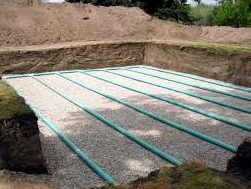
On-site septic systems are estimated to be used by 25% of U.S. households (EPA, 2014). This is because for one reason or another, connecting to the town/city’s sewage isn’t possible or practicle. Additionally, 10% to 20% of these systems will malfunction this year (EPA, 2014). Understanding these statistics is key to understanding why good septic system design is important.
 Engineers have to assess numerous local factors, any of which necessitate changing the septic system design. The most influential of these factors by far are soil characteristics: sandy versus loamy soils, the depth at which you hit ledge (sedimentary rock) or ground water, etc. Additionally, for each of these different conditions there are a corresponding regulatory statutes which must be met.
Engineers have to assess numerous local factors, any of which necessitate changing the septic system design. The most influential of these factors by far are soil characteristics: sandy versus loamy soils, the depth at which you hit ledge (sedimentary rock) or ground water, etc. Additionally, for each of these different conditions there are a corresponding regulatory statutes which must be met.
 Another key component of what goes into the design of septic systems is the absorption rate of the soil, determined by a percolation test(referred to more commonly as the “perc test“). Every town will have different parameters for how the test should be run, but the results are the same: sandy soils will absorb water more quickly than clay-like soils. In terms of septic system design, depending on how close the groundwater is to the surface and this absorption rate, the location of the system vertically and horizontally can be determined.
Another key component of what goes into the design of septic systems is the absorption rate of the soil, determined by a percolation test(referred to more commonly as the “perc test“). Every town will have different parameters for how the test should be run, but the results are the same: sandy soils will absorb water more quickly than clay-like soils. In terms of septic system design, depending on how close the groundwater is to the surface and this absorption rate, the location of the system vertically and horizontally can be determined.
In addition, a “backup” location for a septic system must be designed incase the main system fails or has aged beyond repair. This requires considerable forthought, especially when working on a tight site where structure improvements and soil types may severely limit the placement of the system.
A well engineered septic system easily pays for itself, as it will outlast it’s expected lifespan, require less maintance, and safely assure ground water quality. These are but a few of the standards our engineering team hold themselves to.
